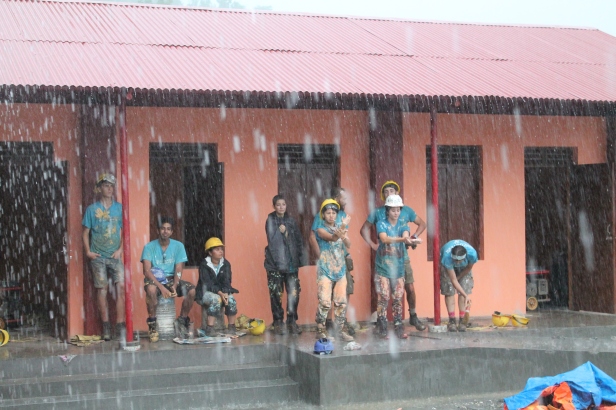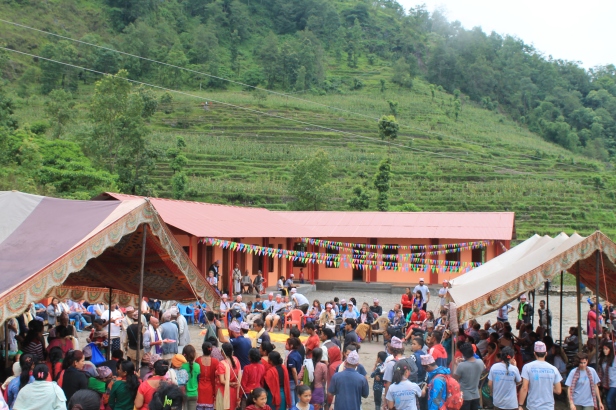The trouble with finishing a construction project in July – or in All Hands’ case, three projects – is that you suddenly find yourself in the middle of monsoon season. You know, that unbelievably wet period where transport basically stops, construction work outside of All Hands stops and general happiness unless you’re a rice paddy owner decreases more than slightly.

Four months ago it was cold during the night, almost freezing, in fact, and hot during the day. It got hotter as the weeks went on until the morning fire wasn’t necessary for warmth as much as for heating water for tea and coffee. More and more volunteers arrived and left on base and gradually the place improved as we realised how much rain was about to descend on us. More tents and toilets were built, a homemade table-tennis table appeared, and slowly but surely more rain arrived. And then more. Big storms came and went, I tried and failed to take photos of lightening, but all the time at the site I worked on – Chamuna School – the weather was boiling with the very occasional abrupt downpour. The other school, Kakaling, had cooler days with more cloud cover and more rain, but we remained sunburned and sweaty, all day every day, six days a week.
It wasn’t until the final two weeks of the project, when we really needed that sunny consistency for the remaining deliveries and ease of final plastering and painting, that the monsoon really affected us.
Nepal’s timing for absolutely everything is absolutely ridiculous.
Late night plastering, painting and daylight monsoon defending
We needed cement and sand to finish the verandas and plastering, paint for the outside walls, inside walls, and any kind of paint-needing part of the building, and a final set of corrugated iron for the eves and gable walls on the third building. They were all late. Partly this was Nepali Time striking once more and part was the monsoon belittling our plans. Getting anything up the road towards Thulo Pakhar is difficult, let alone truckloads of goods up to Thulo and then down the tiny mountain mud track to Chamuna School.
Eventually the cement did arrive, as did the sand – the wrong sand, but sand nonetheless – and finally the paint, not the right paint, but some of the right paint. We then had to wait for more paint, and then more. I do not envy our Logistics Coordinator, Anu, our recent Project Coordinator, Ashok, or anyone else involved with trying to procure those items. It was a nightmare.

The monsoon doing its best to annoy us. . .
With the program in Nepal under-budget and under time-line, it was decided that we could help rebuild one more school within our time frame. This was a school in Jana Khalyan which would almost certainly never have received help due to the logistics of getting people and resources there. The only reason we could was that we had already set up a base an hour and a half away for the other two schools and so AHV threw their remaining budget and energy into completing that as well. Something I for one am immensely proud of and happy to be a part of. What it did mean, though, was that our resources were now split three ways instead of two.
With two weeks remaining until Chamuna was due to be handed over to the community, it was wisely decided that a core team of Team Leaders and long-term volunteers would stay at the school site for the last 9 days in order to complete it in time. The transformation over 4 months was crazy, but the transformation in those last nine days, and specifically last two days, was almost even more so.
Last minute preparations and organising. Much needed.
We’d been painting late into the night, working long hours with none of the basic priveledges that base provided – apart from a portable projector we fell asleep using – when the last two days arrived. Every single person on project Thulo Pakhar who wasn’t in Jala Khalyan ended up in Chamuna on the Sunday before the Tuesday handover. With the paint finally arrived and the last plaster applied, volunteers and staff painted all day, removed extra materials and scraps from the site and destroyed the tool shed; with our PC falling through the roof of part of that shed. An alarming moment on an otherwise epic day.
Ninety five volunteers, masons and staff worked in Chamuna that day and the difference was breathtaking. By the end only some final painting, plaster touch-ups and landscaping were left. Still a full day’s work (if not more), but a momentous effort all told.
Towards the end of Sunday, one day before the handover
It doesn’t matter how much painting gets done if every time you paint a wall the rain washes it off before you can cover it adequately. This happened again immediately after work on Sunday, and during work on Monday. Monsoon wasn’t going to be side-stepped by merely upping the quantity of volunteers. With another sixty or so volunteers on site on the Monday, the site stopped being a construction site and became a school. The morning of the handover ceremony the locals arrived with big marquees, a speaker for the speeches, killed a couple of goats on our old tarpaulins and put up the obligatory – but beautiful – Nepalese flags. With our project manager joining us for the final night and morning, as he had done frequently beforehand because he’s a mad workaholic, we removed the remaining tools, did some final back-filling of the site and painting and put the swing on the playground structure. We were done.
The team with me on those final days in Chamuna worked to exhaustion and I could not have asked for more. They’re all crazy, fantastic people. The base closes down on the 31st July. Kakaling handover is next week, Jana Khalyan is a week and a bit later.
One school down, two to go. I’m going to sleep.

Most of the core team who lived, breathed and sweated Chamuna for months.


Before and after. Enough said.
To support All Hands Volunteers more so they can carry on building schools once the monsoon finishes please donate or volunteer yourself. They need all the help they can get.

















Well done Phil. I am very pleased to be associated with the first two schools mentioned. Dangerous Dave :))
LikeLiked by 2 people
Thank you dangerous Dave, your efforts made a big difference!
LikeLike
What an amazing achievement, Phil! Congratulations to you and the AHV stalwarts on completing such a successful project and good luck with the remaining two schools. What a wealth of experience you’ve gained and what incredible tales you’ll have to tell when you return to the UK! Can’t wait to hear them. Much love, Sally. xx
LikeLiked by 1 person
Thank you Sally! I’ll pass on your congratulations to my companions! See you in a few months! x
LikeLike